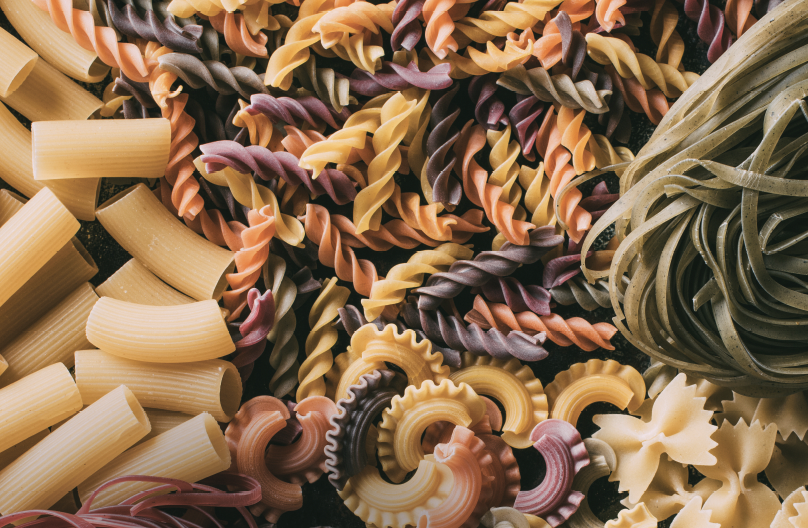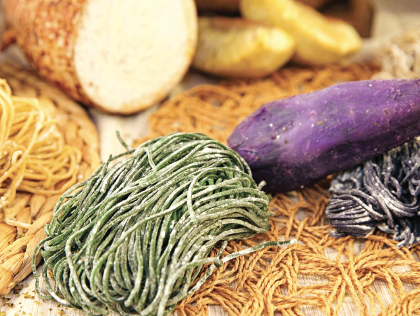Endless Pastabilities


From the humble, familiar straight Italian spaghetti noodle, pasta has multiplied over the centuries to encompass 350 varieties and shapes, each purported to best showcase the sauces and ingredients of a particular region.
Legend has it that Italy’s romance with the noodle began when Marco Polo introduced his food finds from 13th century travels to Asia. In reality, pasta had already been enjoyed by Italians since the ninth century.
The earliest pasta was cut with knives out of sheets of dough into strips of varying thicknesses. Spaghetti, which translates as “little strings,” was the basic form of pasta, introduced in the ninth century.
There is no reason to believe the Italians did not come up with the recipe of flour, eggs, salt and water on their own, but one sign of outsider influence emerged in Sicily, where 250 years of Arab rule over the island beginning in the early nineth century, led to their cultural imprint on food. Spaghetti was boiled and eaten by hand with ingredients such as cinnamon and raisins.
Pasta’s soulmate — the tomato — had yet to arrive from the New World, so the earliest dishes were flavored with pantry staples of garlic, onions, cheese, pepper, olive oil or butter, and Mediterranean herbs.
Technology developed during the Renaissance of the 15th and 16th centuries led to the development of extrusion machines allowing mass production of pastas. Bronze dies were used to shape dough into previously unimaginable shapes such as tubular rigatoni and macaroni. The tomato arrived in Italy in 1548, but it took another four centuries for Italians to accept it as edible. They were wary of its status as a member of the poisonous nightshade family, and it took modern scientific evidence to convince them tomatoes were fit for human consumption.
Another innovation came later when pasta flavors were enhanced by the addition of basil, red peppers, spinach, tomatoes, or squid ink to the dough. Locally, Adela’s Country Eatery offers several flavored noodles to eat in-house or in dry form to cook at home. Flavors include avocado, moringa, Okinawan sweet potato, taro and ulu.
Considering the joy of a simple dish of spaghetti with tomato sauce and meatballs one would imagine there was no need to reinvent the noodle. But a pasta’s shape can enhance the dining experience by the way it supports and grips particular sauces.
Here are a few varieties and the sauces that work best with them.
ANGEL HAIR: Also known as capellini (“little hairs”) or capelli d’angelo, this thinnest of pasta noodles requires the lightest of saucing, or combinations of nothing more than butter, garlic and herbs, or butter, garlic and Parmesan.
CONCHIGLIE: Also known as "shell pasta” because of its resemblance to seashells, this pasta can be added to soups or used as the base of salads. They can be substituted for macaroni in mac n’ cheese dishes, and their nooks are well-suited to hold on to hearty ground beef sauces.
FARFALLE: This pasta is often referred to as bow tie pasta because of its resemblance to the familiar piece of men’s formal neckwear. The weight of this pasta will hold up to stir-fries of chicken and roasted garlic, to brightening a Mediterranean-style cold salad.
FETTUCCINE: This long, flat pasta with a name that means “little ribbons,” holds up well with a variety of sauces, but is most closely linked to the creamy Alfredo sauce.
LASAGNA: These wide, flat sheets of noodles have one purpose, to support layers of meat, cheese, sauce and vegetables baked into the famed casserole that bears its name.
LINGUINE: This ribbon-like flat pasta offers a good showcase for a variety of sauces, from a simple stir-fry of butter and garlic topped with scampi, to white wine with butter and lemon tossed with clams, or a creamy mushroom sauce.
MACARONI: This is one of the most popular forms of pastas, known to every kid who grew up with macaroni and cheese. It’s a nostalgic adult favorite as well, when incorporating more elaborate combinations of cheeses and extra ingredients as lobster and bacon. This versatile noodle is also included in soups and salads.
PAPPARDELLE: This broad, flat noodle originated in Tuscany and holds up well to weightier, meatier sauces such as a Bolognese or mushroom ragout.
PENNE: Pairs well with any type of sauce but is especially well-suited to chunky sauces that match its heft. This shape is also great for baking with meat, cheese and tomato sauce.
RIGATONI: Its ridges, thickness and tubular shape make it perfect with any weighty sauce, holding cream, cheese and chunky meat sauces in its ridges and crannies.
